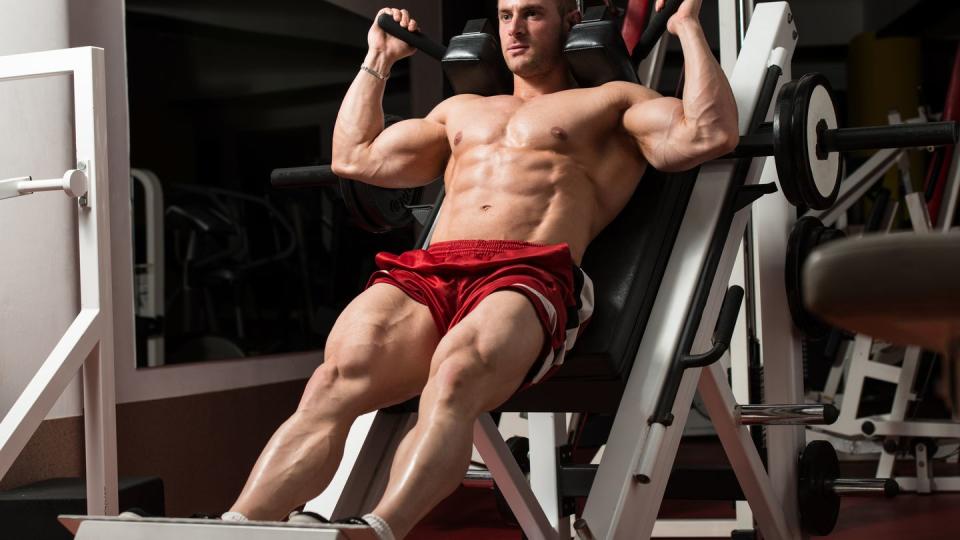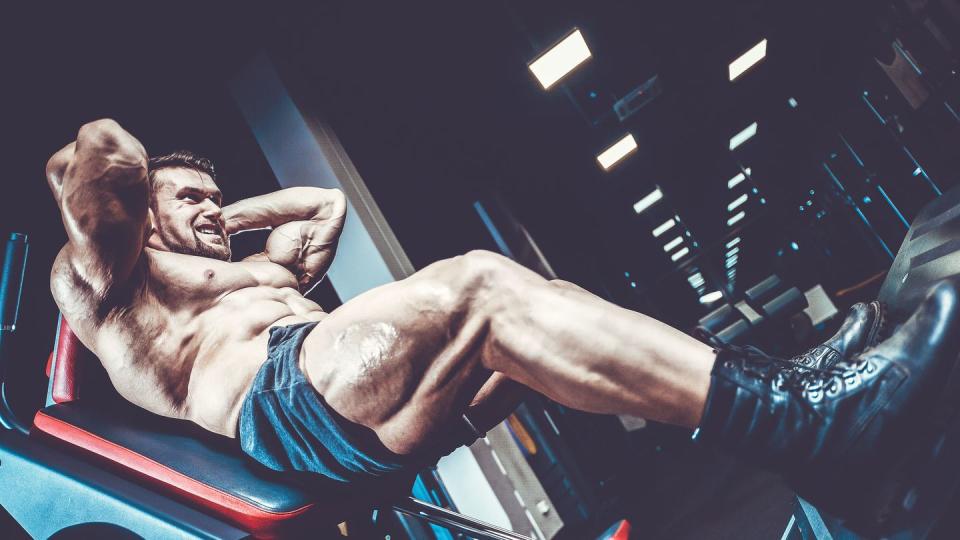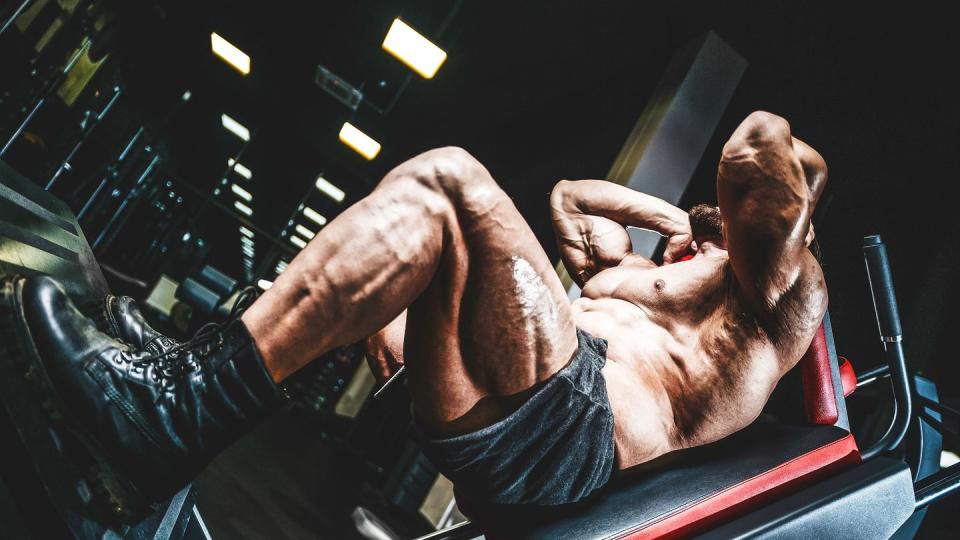Want Monster Quads? Time to Learn the Hack Squat.
LEG DAY OFTEN MEANS one thing for the vast majority of exercisers: It's time to squat. There's good reason why squats are commonly the backbone of lower body routines. The compound movement gives lifters an opportunity to train the biggest muscles in their legs, and most guys' go-to variation, the barbell back squat, allows for heavy loads to build up both strength and muscle. Once you go beyond the basics of strength training and commonly accessible gym gear, however, you can introduce even more squat variations in your routine for different points of focus, like the muscles in your legs. That's where the hack squat comes into play as one of the best ways you can home in on your quads.
There are other exercises you can do that will give your quads (formally the quadriceps femoris, the four-part muscle on the front of your thigh) a great deal of engagement, including lunges, machine-based moves like leg extensions, and of course the aforementioned barbell squat (both the back and, to an even greater degree, front squat). But once you've got to a certain point, you might be looking for more options to home in on quad development. That's where the hack squat comes into play.
You might never have heard of this lift, especially if you've only ever trained at a cookie-cutter gym with access to only basic equipment. That's okay. Let's explore the history of the move, why you'd want to include it in your workouts, and, even more helpfully, show you how you can pull it off without specialized gear.
Benefits of Adding the Hack Squats to Your Workouts
Here’s the thing about squats: Each version of the squat (front, back, hack, and many others) changes the mechanical demands on your legs. In doing so, it changes the muscles you’re stressing most. The hack squat adjusts the squat by stabilizing your back and placing the primary emphasis on the quads.
This is one of the go-to exercises I will add in for clients if they are looking to aesthetically upgrade their legs. Hypertrophy and strength gains are dependent on pushing the muscle groups you want to upgrade with regularity, and when it comes to leg training, that often means you need to do more than squats and deadlifts. Don’t get me wrong: The back squat and deadlift will be your bread-and-butter moves. But hack squats can carve details where you want them.
It’s not a perfect lift (which is why we’re not using it to replace squats and lunges). But it is a useful one. Read on, and I’ll tell you the ups and downs of the hack squat.
Where Did the Hack Squat Come From?
The hack squat, along with the bench press, are generally credited to George Hackenschmidt. Hackenschmidt was a highly decorated weightlifter and wrestler who ultimately earned a spot into the National Wrestling Hall of Fame, and he wanted a different leg exercise. He wanted a squat that had a simple goal: Build strength. And no, that didn’t mean adding mobility or making you a monstrous leaper.
Hackenschmidt just wanted to build strength, and by taking his back out of the equation, he had chances to move large weights. The hack squat became a basic move in the late 1800s and early 1900s. These days, it’s largely relegated to gyms that embrace bodybuilding and weightlifting.
How the Hack Squat Works
The hack squat varies from other similar, squat-style movements primarily for two reasons: Weight placement and back position. These may seem like small details, but they completely change the emphasis of the move. Depending on your goals, these little adjustments can be terrific, or not worth a second of your time.

Weight Placement
Most of the big changes in squats come down to where the weight is rested. The front squat and back squat vary so much because of the few inches in different placement on the body; the back squat places the load behind the shoulders (changing the torso angle required to keep them directly above your hips). The front squat shifts the weight slightly in front of the shoulders, allowing for a fully upright torso to keep the weight above the hips, and a very tight core.
The hack squat, meanwhile, has the weight placed directly on the shoulders. With the weight directly on top of the shoulder, your upper body has less responsibility and challenge keeping it directly over your center of gravity. On the one hand, this means less unnecessary stress to the total body, so you focus on leg movement more. (On the other hand, it removes the upper body stability demands you face in a free-weight squat.)

Back squats require a lot of posterior muscle recruitment, so you’ll see a lot more activation at the glutes than you do in other squats. There’s also added hip flexion (bending at the hips) when you go into the bottom of a squat, so your glutes and hamstrings are called upon to drive the weight back upwards. Front squats, meanwhile, often hammer the quads, because their upright position can force your lower legs to stay perpendicular to the ground. That can help you attack your quads, but even then, there are ways to take stress off your quads.
The hack squat forces upright positioning because of the placement of weight. There is no realistic way to lean forward with the upper body while maintaining the attachment on your shoulder. This insures your quads are key drivers in the push up. The combination of placement on the shoulders and more upright posture also means you have less stress through the shoulder joint. Front squats and back squats require you to stay focused on upper body positioning to control the free bar. When hack squatting, a machine is handling the stabilization, so you can focus fully on what your lower body does.
Fixed Back Position
For all the good about the hack squat, there are often issues with the fixed back position. If you haven’t heard of “butt wink,” it’s something you must constantly be aware of when hack squatting. It’s a common occurrence at the bottom of a squat, when your lower back rounds ever so slightly. It happens when there’s no more range of motion possible at either the knee or hip to get deeper into the squat, so the neighboring joints (in this case, your lumbar joints) assist in gaining space.
The hack squat can alleviate general back stress in a limited range of motion, but as you attempt to go lower, you can place yourself in a compromising spot. Placing the back against a board and going too deep when hack squatting leaves a lot of flexing stress for the lumbar spine if you have limited mobility.
This isn’t always an issue. I have had clients in the past with previous lumbar issues, including myself, who feel better with the hack squat. This could be because of the ability to lean back into the pad with standing back up from the move. The important thing to understand is because of the fixed back position, your natural chain of movement is altered. So don’t bounce quickly through the motion. Being in complete control during the concentric and eccentric phases of the hack squat are critical. When you lose focus on the form, your lower back has to do too much from a strength standpoint. You don’t want that, especially as you hack squat heavier loads.
How to Do the Barbell Hack Squat
If you don't have access to a machine, you can still replicate the hack squat in a standard gym using a barbell and some weight plates. The key to the barbell hack squat is moving the bar from your shoulders to directly behind you, starting with the weight on the floor. That way, you're still able to take the load off your shoulders and focus on your lower body while working with heavy weights. Elevate your heels on a pair of plates, and your knees will shift over your toes, emphasizing your quad engagement.
Start standing with your feet about shoulder-width apart and heels elevated on a pair of plates. The loaded barbell should be behind you on the ground.
Squat down to grip the bar with your hands at about shoulder-width apart, palms facing out, then drive off your heels to stand back up.
Keep your neck in neutral, with your gaze focused down and just ahead of you. Squat down and control the weight down to the floor on each rep, then stand straight up and squeeze your quads.
You will be limited by what your grip strength can handle, but you'll be able to challenge your legs with greater loads than other non-machine movements like goblet squats.
When You Should Do The Hack Squat
When you hack squat depends heavily on your goals and how long you’ve been training. Here’s a rundown of how I’d use one of the gym’s more intricate lifts. And remember: the hack squat shouldn’t be your top leg exercise. You still want to do barbell squats and deadlifts.

Who Should Do the Hack Squat
You Are New to Squats
Squatting motions aren’t as intuitive as you think. We get so used to standing, and we squat so infrequently in our day-to-day life that the motion can be foreign. When I descend down, the natural first instinct is to shift the knees forward and try to keep my torso over my ankles. That doesn’t work, but relearning the motion can be tricky.
Squatting motions actually require you to stand through the back half of your foot (midfoot to heel), weight in your heels, and essentially push your butt back. Then you push up through your heel. This neuromuscular connection can be developed on the hack squat. If you are looking to load on some weight and build confidence through lower body mechanics, the hack squat is a great move to have in your workouts. Slowly learn to drive through the back half of your foot and master your leg strength.
You Want to Put on Muscle Mass
There are two main machine lifts you’ll see guys doing to build their legs, the hack squat and the leg press. And let’s be very clear about this: they’re different lifts. The leg press moves the legs toward the body. The hack squat moves the body toward the legs. Most of our real-life movement involves the body moving toward the legs, so it makes sense to mimic that in our squat variations and training.
As I mentioned before, the hack squat is especially great if you’re trying to slam your quads. It will leave your legs fatigued, I guarantee you that; think 3 sets of 10 to 12 reps.
Who Should Not Do the Hack Squat
You Have Joint Issues
The hack squat is a fixed motion. That doesn’t always help those with knee or hip issues. While the hack squat removes some stabilization aspects of regular squats, it still asks for near-full-body involvement. Placing someone under load through a fixed range of motion with knee issues or lower spine issues can be a recipe for chronic pain. If you have lower back or knee issues, move on.
Your Goal Is Performance
If you’re trying to get more athletic for basketball or football, or any sport, the hack squat may not be the best exercise for you. On the one hand, any kind of strength will help you perform better, and you definitely will build strength when you hack squat.
But it’s not the best use of your time. It’s not challenging you to stabilize through your upper body and not letting you use your lower body in an athletic, natural way. If you’ve done your free-weight squats, deadlifts, lunges, and frontal-plane leg moves, sure, throw the hack squat in. But if your goal is to perform on a field of play, make the hack squat a very low-priority leg exercise. In athletics, the environment won’t offer as many fixed variables as the hack squat does.
You Might Also Like

